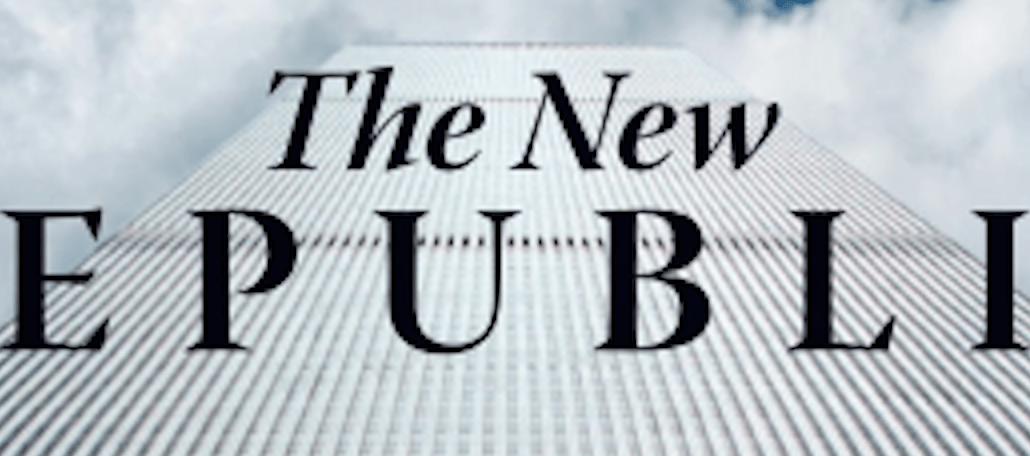Save 50% on a 3-month Digiday+ membership. Ends Dec 5.

The New Republic CEO Guy Vidra has called for massive changes at the 100-year-old institution, contributing to a massive staff exodus four months ago, but has been short on specifics. Now, it’s clear that native is going to be a big part of that future.
In one of Vidra’s first tangible moves as CEO, he is scheduled to announce the hire of Kayvan Salmanpour, as chief revenue officer. Salmanpour is a veteran content marketer. He spent the past four years building content-marketing platform Newscred, as vp of sales. Before that, he was CEO of Mediaplanet, a content-marketing agency. He’s scheduled to start March 30 and will be based in the title’s New York office.
It’s an atypical résumé for a CRO, but just about every publisher realizes it needs to double down on native as brands move more of their marketing spending to ads that resemble content as traditional digital ad formats lose effectiveness.
“As brands shift more of their marketing budgets toward content development, it is important that we help our ad partners develop content that engages our coveted audience — both within and outside our walls,” Vidra wrote in a memo to staff announcing Salmanpour’s hire. “As a leader and innovator in the space, Kayvan is ideally suited to drive our business team forward in this exciting direction.”
Salmanpour will oversee all revenue for the company, including digital, print and events, and build a team to provide creative services for advertisers, building on work the title has done for clients including Credit Suisse and Southern Company, according to Vidra.
The memo is notable for its straightforward tone, in contrast to the Vidra’s comments of the past. The former Yahoo executive was criticized for his Silicon Valley-laced jargon when he spoke in a company meeting about digital disruption and the need to “break shit.” His style clashed loudly with the 100-year-old journal of politics and culture and came to symbolize the disconnect between the tech and media cultures.
On the heels of that meeting, The New Republic suffered a mass exodus of staff, including two top editors, and the publication has been trying to find its footing ever since.
Under owner Chris Hughes, one of Facebook’s founders, The New Republic has ushered in a new digital design and launched new apps. But making the digital transition is tricky for a niche publisher like The New Republic. Its audience is older, and the long, analytical articles it’s known for aren’t suited to the Web, where playful or emotion-driven posts are rewarded. Other high brow publications like The Economist and The Financial Times have pushed attention metrics over a click-based ad buying model, with limited success. (They also have strong subscription-revenue streams that offset their reliance on advertising.)
Native advertising holds out a big opportunity for influential publications, as The Atlantic and The New York Times have shown with their recent work for brands like Shell and Netflix. But as they made strides in this area, it becomes all the more important for a relative newcomer like The New Republic to match if not exceed their offerings if it wants to be competitive with them.
“Native feels like a natural fit for TNR, but even there they need to differentiate from the pack,” said Eric Franchi, co-founder of Undertone.
The New Republic also has a size issue, which will make it a hard sell with many advertisers; a recent report by comScore put its desktop monthly uniques at just 1 million.
“Clearly, this will require a commitment to their digital platforms, which from my cursory review, they seem to be making,” said Eric van den Heuvel, managing director of The Gate Media. “Without a strong digital platform for distribution and multimedia engagement — it would not work. The challenge, specific to The New Republic, will be, are advertisers willing to make the investment of time and dollars with a smaller media brand and pretty unique audience?”
More in Media

AI-powered professional learning and the battle vs. ‘workslop’: Inside Deloitte’s Scout
Deloitte last month launched Scout as part of its Project 120, the company’s $1.4 billion investment in professional development.

‘The Big Bang has happened’: Reach gets proactive on AI-era referrals, starting with subscriptions
This week, the publisher of national U.K. titles Daily Mirror, Daily Express and Daily Star, is rolling out its first paid digital subscriptions – a big departure from the free, ad-funded model it’s had throughout its 120-year history.

Arena Group, BuzzFeed, USA Today Co, Vox Media join RSL’s AI content licensing efforts
Arena Group, BuzzFeed, USA Today Co and Vox Media are participating in the RSL Collective’s efforts to license content to AI companies.





